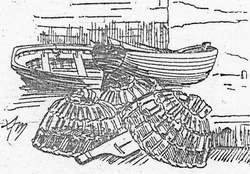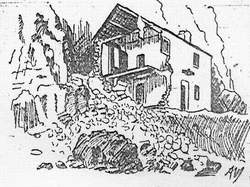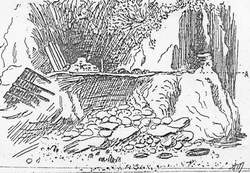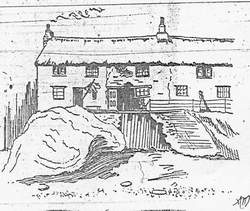Abandoned Communities ..... Hallsands
We will return a little later to look at what happened to the people of Hallsands after they were compelled to abandon their village. First I would like to focus in more detail on the way the events of 1903-04 and 1917 were reported in the regional press. We know a lot about those events, and we know it thanks to the thorough work of papers such as the Western Daily Mercury and the Western Morning News. Their “representatives” provided vivid descriptions of the storms that battered Hallsands and the damage they caused, from time to time they summarised the history of the destruction, being clear that it should be attributed to the dredging, and they would offer recommendations on what needed to be done to put things right. In general the quality of reporting was very high.
“Representatives” of the newspapers usually remained anonymous. In March 1904, however, a representative identified by the initials AES provided a report that was more than a little over the top. He compared the destruction of Hallsands to the fate of Carthage. One house, belonging to a fisherman with seven children, was now scattered and divided amongst the denizens of the deep. Elsewhere a terraced garden had been carried off for the mermaids’ use, and at the further end of the village naught but the garden wall was left of a former home, where love once grew and confidences were oft exchanged.
Please let me know if you believe you know the identity of AES.
No photographs appear in the newspapers of 1903-04. Instead articles about Hallsands were sometimes illustrated with sketches. Four sketches published in the Western Daily Mercury on 24 September 1903 will be reproduced at the foot of this page.
The Western Daily Mercury and the Western Morning News can be read at Plymouth Central Library. Unless you have a very strong reason for doing so you will not be allowed to see the original newspapers, but you can read them on microfilm and many of the articles on Hallsands have been photocopied and brought together in a folder in the Local History section of the library.
One feature of the reporting was the extent to which representatives would seek interviews with the fishermen and their families. They would often provide lengthy quotations from these interviews, no doubt in English that was considerably tidied up from the original. After the storms of 27 February 1903 Mr George Lobb, the landlord of the London Inn, was quoted in the Western Morning News as saying “When the greenhouse collapsed two coastguardmen and two fishermen came to assist me to remove the things in the bedroom. While we were in the room the roof came down upon us, and we all had a narrow escape. Then the gable gave way, tearing away the stove and nearly blinding us with dust. It was with the greatest difficulty that we grasped things to prevent us from falling into the surf. My wife also had a very narrow escape. We had arranged to have tea, as usual, in the kitchen. Mrs Lobb was sitting down when the wall gave way, but not in her customary place, otherwise she would have certainly fallen and perished in the surf. We hurriedly removed all articles of furniture, and had just got out the last, when the whole pile went like a pack of cards. The noise and the dust was bewildering, the latter enveloping the assistants and myself. I heard the bystanders shout ‘What has become of the men?’”
After the storms early in March 1904 the Western Morning News described the loss of Mrs Logan’s home. Mrs Logan was a widow over 70 years of age, who owned one of the nicest little abodes in the centre of the village. She tearfully stated how very hard it was, after a lifetime of thrift, to have her abode washed down, and she, but for the hospitality of her neighbours, to be homeless.
In the same article Robert Steere described the damage to his house early on the Saturday morning. “The sea came right into the bedroom windows, saturated our bedding and most of our furniture. We lost no time in clearing all this out; but our principal difficulty [was] with Anne Trout. We let her stay in the house until the last, but, feeble as she was, she had to go. The sea now commenced to rip the thatch off the roof, and the water poured down in torrents. From there and through the windows the water got so great that we had to bore holes in the bedroom floor to let it down into the kitchen, and in the kitchen we made another hole in the side of the wall, for the water to escape again into the sea.”
“Representatives” of the newspapers usually remained anonymous. In March 1904, however, a representative identified by the initials AES provided a report that was more than a little over the top. He compared the destruction of Hallsands to the fate of Carthage. One house, belonging to a fisherman with seven children, was now scattered and divided amongst the denizens of the deep. Elsewhere a terraced garden had been carried off for the mermaids’ use, and at the further end of the village naught but the garden wall was left of a former home, where love once grew and confidences were oft exchanged.
Please let me know if you believe you know the identity of AES.
No photographs appear in the newspapers of 1903-
The Western Daily Mercury and the Western Morning News can be read at Plymouth Central Library. Unless you have a very strong reason for doing so you will not be allowed to see the original newspapers, but you can read them on microfilm and many of the articles on Hallsands have been photocopied and brought together in a folder in the Local History section of the library.
One feature of the reporting was the extent to which representatives would seek interviews with the fishermen and their families. They would often provide lengthy quotations from these interviews, no doubt in English that was considerably tidied up from the original. After the storms of 27 February 1903 Mr George Lobb, the landlord of the London Inn, was quoted in the Western Morning News as saying “When the greenhouse collapsed two coastguardmen and two fishermen came to assist me to remove the things in the bedroom. While we were in the room the roof came down upon us, and we all had a narrow escape. Then the gable gave way, tearing away the stove and nearly blinding us with dust. It was with the greatest difficulty that we grasped things to prevent us from falling into the surf. My wife also had a very narrow escape. We had arranged to have tea, as usual, in the kitchen. Mrs Lobb was sitting down when the wall gave way, but not in her customary place, otherwise she would have certainly fallen and perished in the surf. We hurriedly removed all articles of furniture, and had just got out the last, when the whole pile went like a pack of cards. The noise and the dust was bewildering, the latter enveloping the assistants and myself. I heard the bystanders shout ‘What has become of the men?’”
After the storms early in March 1904 the Western Morning News described the loss of Mrs Logan’s home. Mrs Logan was a widow over 70 years of age, who owned one of the nicest little abodes in the centre of the village. She tearfully stated how very hard it was, after a lifetime of thrift, to have her abode washed down, and she, but for the hospitality of her neighbours, to be homeless.
In the same article Robert Steere described the damage to his house early on the Saturday morning. “The sea came right into the bedroom windows, saturated our bedding and most of our furniture. We lost no time in clearing all this out; but our principal difficulty [was] with Anne Trout. We let her stay in the house until the last, but, feeble as she was, she had to go. The sea now commenced to rip the thatch off the roof, and the water poured down in torrents. From there and through the windows the water got so great that we had to bore holes in the bedroom floor to let it down into the kitchen, and in the kitchen we made another hole in the side of the wall, for the water to escape again into the sea.”
Four
Crab pots
The home of the Trouts after February 1903
The home of the Trouts after September 1903
The damage to Mr Holdsworth’s house
These sketches, and the map from R Hansford Worth’s article on page two, are reproduced with the permission of Plymouth Library Service



